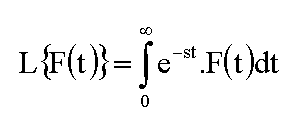Analysis of a Series-RLC Circuit Using Laplace Transforms Part 01
Why Laplace Transforms?
When I started this project I did look around for clues as to the best way to approach the analyses. As I’ve already mentioned, there wasn’t a great deal written about the exact scenario I was trying to tackle, and the majority of what there was seemed to focus on calculus-based approaches. Now, I’ve nothing against calculus, I might even say I like calculus, but niggling away at the back of my mind was a memory of something which might, provide a simpler and more direct approach: Laplace Transforms.
Probably like many engineers, my exposure to the Laplace method came at college where I learnt the basics in order to pass an exam and then immediately forgot all about them. Fortunately, enough of a memory lingered to at least point me in the right direction, although with little useful knowledge except that the letter “s” was used a lot.
Now, open any textbook on Laplace Transforms and you’ll probably be confronted by the following:
When I started this project I did look around for clues as to the best way to approach the analyses. As I’ve already mentioned, there wasn’t a great deal written about the exact scenario I was trying to tackle, and the majority of what there was seemed to focus on calculus-based approaches. Now, I’ve nothing against calculus, I might even say I like calculus, but niggling away at the back of my mind was a memory of something which might, provide a simpler and more direct approach: Laplace Transforms.
Probably like many engineers, my exposure to the Laplace method came at college where I learnt the basics in order to pass an exam and then immediately forgot all about them. Fortunately, enough of a memory lingered to at least point me in the right direction, although with little useful knowledge except that the letter “s” was used a lot.
Now, open any textbook on Laplace Transforms and you’ll probably be confronted by the following:

at which point you may well scream, slam the book shut and run from the room.
This is the basic definition of the Laplace Transform, and I’m not in any way trying to say it’s wrong (it isn’t), what I am saying is that you don’t need to use the definition, or even be aware of it, in order to carry out perfectly valid and useful circuit analysis using the Laplace method. In fact, in all the analyses that I will demonstrate, I will not refer to this definition even once.
Benefits of the Laplace method.
In terms of ease-of-use, the Laplace method has the following huge benefits:
I hope to convince you of these advantages when I demonstrate the details of the Laplace method.
Here is the link to the pdf:
Laplace Analysis Paper 01
This is the basic definition of the Laplace Transform, and I’m not in any way trying to say it’s wrong (it isn’t), what I am saying is that you don’t need to use the definition, or even be aware of it, in order to carry out perfectly valid and useful circuit analysis using the Laplace method. In fact, in all the analyses that I will demonstrate, I will not refer to this definition even once.
Benefits of the Laplace method.
In terms of ease-of-use, the Laplace method has the following huge benefits:
- No need for calculus.
- Transforming circuit elements from the ordinary time-domain (t-domain) into their Laplace (s-domain) equivalents is extremely simple.
- Once transformed, the s-domain elements can be added, subtract, multiplied and divided just like ordinary resistances in the t-domain.
- Transforming back into the t-domain is usually only a matter of carrying out straightforward algebraic manipulations, and hence determining the final answer is also straightforward.
I hope to convince you of these advantages when I demonstrate the details of the Laplace method.
Here is the link to the pdf:
